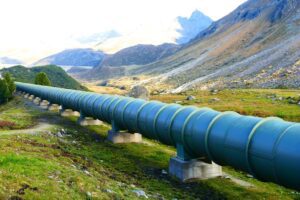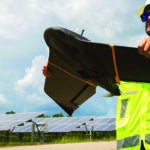An East Coast industrial plant had for months experienced a significant dropoff in energy production from its 36,000-square-foot solar field. The plant’s maintenance team had been unable to find any problems with the solar panels during routine thermal/infrared monitoring from the ground.
It was time to send in the drones (Figure 1). Plant and facility managers looking for an efficient, safer, and less-expensive alternative to traditional thermographic inspections of solar fields and wind farms are increasingly looking at drones, or unmanned aircraft systems (UASs), to perform such inspections.
 |
|
1. This drone has been used by Infrared Testing Inc. to perform aerial inspections of energy equipment in Chicago, Illinois. Courtesy: Infrared Testing Inc. |
At this particular solar field, Infrared Testing Inc. (ITI), a Chicago-based thermographic testing company, brought in a custom drone equipped with high-resolution digital and infrared cameras, and connected to GPS satellites by real-time kinometric (RTK) positioning. The resulting images showed numerous defective cells on 30 solar panels. The cells were repaired, resulting in improved system performance and reduced energy costs.
During traditional thermographic inspections of rooftop solar fields, there is rarely enough space to crawl under the panels to get straight-on, close-up images. Instead, technicians climb to the roof and walk the perimeter, scanning the rows of solar panels at an angle, which makes it more difficult to detect anomalies. The data also becomes less reliable because of reflections. Flying a drone over the roof, and close to each panel, helps reduce the reflections and enables the drone to capture more accurate images (Figure 2).
 |
|
2. These images provide a digital (top) and infrared (bottom) look at the same set of solar panels. The drone that provided the pictures was equipped with high-resolution digital and infrared cameras. Infrared photos can identify physical damage and structural defects in a variety of energy equipment. Courtesy: Infrared Testing Inc. |
Faster, Safer, and More-Efficient Inspections
Traditional thermal inspections may take days, and can involve several technicians, depending on the size of the solar field. Contrast that with a drone that can be launched in minutes by a single technician and can photograph 95,000 square feet of solar panels in just 45 minutes, on average. A drone also can inspect multiple wind turbines in the time it used to take to climb just one. Use of a drone also eliminates the risk of inspectors being injured as they climb on structures or use harnesses and ropes to maneuver around a turbine, a job that could take days.
A trained technician begins a drone inspection by connecting the drone to the RTK, a satellite navigation technology used to enhance the precision of position data derived from satellite-based positioning systems such as GPS. RTK uses measurements of the phase of the signal’s carrier wave as well as the signal’s information content, and relies on a single reference station to provide real-time corrections, providing up to centimeter-level accuracy. The technique enables the drone to fly more accurately and stay stationary when hovering and taking images, resulting in more accurate data and fewer run-ins with turbines or solar panels.
Thermal and high-resolution imagery/data help the thermographer identify, classify, and localize each anomaly in a clear and consistent manner, and understand the impact of its performance on the system. Once the data is analyzed by experts back at the office, it is shared with the end-user, who then has a complete picture of the site and what needs to be done to repair the system.
To test a turbine, the technician flies the drone up the length of the shaft to find any structural defects, and then around the blades to look for damage from birds, flying debris, or severe weather events. When defects are identified, the drone is flown in closer to capture more detailed images.
According to the U.S. Department of Energy, wind energy generated by more than 80,000 turbines contributed 6.3% of the nation’s electricity supply in 2017. It is important to perform regular inspections of these turbines so as to detect structural problems before they become more extensive and significantly impact energy performance.
Drones also may be used to do infrared testing for mold, moisture, and physical damage to a roof membrane, as well as structural defects in a building envelope such as gaps in insulation, air leaks in windows and openings, and sealing issues. These anomalies may result in costly energy losses and repairs if left unchecked.
Annual Solar and Wind Equipment Inspections Save Money
ITI recommends that a plant or facility manager schedule an annual thermographic drone inspection depending on the plant’s location and its exposure to extreme weather such as freezing, hail, lightning, storms, heavy winds, and prolonged rain. Additional inspections may be necessary after a severe weather event that could cause damage and put extreme stress on turbines or solar panels. Corrosion and oxidization on turbine blades, or cell degradation of solar panels, can continue to build and impact energy performance, resulting in costly repairs and system downtime.
Facilities also should plan a first infrared inspection of wind turbines or solar panels during the commissioning process to ensure workmanship/manufacturing errors are found before warranty terms expire.
Last but not least, it is important to use professionals who have been trained in the use of commercial drones and thermographic testing. A drone hobbyist or a company that installs and maintains turbines and solar panels will most likely not be able to gather the most-accurate data and interpret it correctly without proper training and experience.
ITI is seeing increased demand for infrared drone testing as the technology becomes more affordable and easier to use, and as more industrial companies become environmentally conscious and begin supplementing their electrical power with renewable energy. Regular thermographic drone inspections are crucial to the effective maintenance of turbines and solar panels in order to maximize power generation, extend the life of the system, and deliver a higher return on investment. ■
—Tim Leggett is a Level 1 thermographer from the Infrared Training Center and a certified Federal Aviation Administration Part 107 UAS remote pilot with Infrared Testing Inc.










